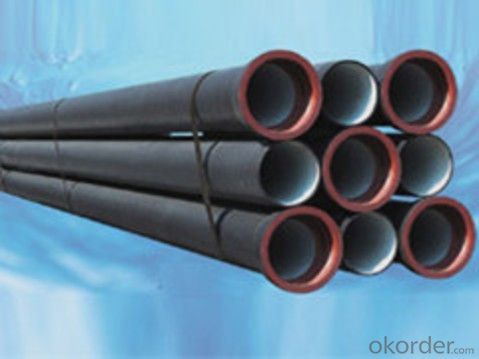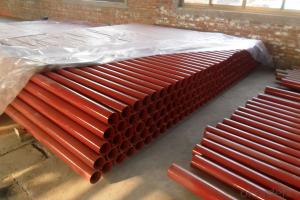Ductile Iron Pipe ISO2531 / EN545 / EN598 K9
- Loading Port:
- China main port
- Payment Terms:
- TT OR LC
- Min Order Qty:
- 200
- Supply Capability:
- 10000 /month
OKorder Service Pledge
OKorder Financial Service
You Might Also Like
1,Ductile Iron Pipe Description :
1) Pipes confirm to ISO2531,K9 class,T type joint,6m long,with inside cements lining conform to ISO4179, outside Zinc spraying(130g/m2) and bitumen coating(70μm) conform to ISO8179.
2) Pipe ends: Spigot and socket ends, with 100% SBR rubber gaskets
accoding to ISO4633
3) we can do third party inspection according to customer's request.
4) Our products have been sold to many international market,
such as Middle East and South East Asia and Africa.
2,Main Features of the Ductile Iron Pipe:
·High yield strength
·High tensile Strength
·High corrosion resistance
·Pressure Resistence
·Anti-corrosion
·Installation is convenient
·Satisfy the highest hygienic standards
3,Ductile Iron Pipe Images:


4.FAQ:
We have organized several common questions for our clients,may help you sincerely:
Q: Why would you choose ductile iron pipe rather than other pipe materials?
A:The reasons are obvious for that not only ductile iron pipe possesses the inherent strength and flexibility of ductile iron, combined with proven corrosion protection systems, but also the cost savings can be achieved from design to installation and commissioning.
Q:Why can you guarantee the inner of pipes can’t be corroded?
A: High alumina cement mortar lining and sulphate-resistant cement mortar lining. These two special linings are applicable to inner anti-corrosion for sewage pipes, improving resistance to erosion of the sewage components.
- Q:What is the minimum cover requirement for ductile iron pipes?
- The specific project or engineering design considerations typically determine the minimum cover requirement for ductile iron pipes. However, as a general rule, it is often recommended to have a minimum cover requirement of at least 2 feet (or 0.6 meters) from the top of the pipe to the finished ground surface. This recommendation helps protect the pipe from external loads, soil settlement, and potential damage during construction activities. Additionally, it contributes to the long-term structural integrity and durability of the ductile iron pipe system. It is crucial to consult local building codes, industry standards, and project specifications for accurate and up-to-date information on specific minimum cover requirements.
- Q:What are the common methods for leak detection in ductile iron pipes?
- There are several common methods for leak detection in ductile iron pipes. These methods are widely used by professionals in the field to identify and locate leaks in a timely manner. 1. Acoustic Leak Detection: This method involves using specialized equipment to listen for the sound of water escaping from the pipe. The equipment detects the sound of the leak and helps pinpoint its location. This method is effective for both pressurized and non-pressurized pipes. 2. Visual Inspection: Visual inspection involves physically inspecting the pipe system for any visible signs of leaks such as water stains, wet spots, or puddles. This method is relatively simple and can be effective for detecting visible leaks in accessible areas. 3. Pressure Testing: Pressure testing involves pressurizing the pipe system and monitoring for any drops in pressure. If there is a leak, the pressure will drop, indicating its presence. This method is commonly used during installation or maintenance and can help identify leaks in inaccessible areas. 4. Infrared Thermography: Infrared cameras are used to detect leaks by measuring temperature differences. Water escaping from a pipe can create a temperature difference, which can be detected by the camera. This method is particularly effective for identifying hidden leaks behind walls or underground. 5. Tracer Gas Testing: Tracer gas testing involves injecting a specific gas, such as helium or hydrogen, into the pipe system. If there is a leak, the gas will escape and can be detected using specialized equipment. This method is highly sensitive and can locate even small leaks. 6. Soil Gas Monitoring: This method involves monitoring the soil around the pipe for the presence of gases emitted by leaking water. By analyzing the soil gas composition, professionals can determine the location of the leak. It is important to note that the choice of method may vary depending on the specific circumstances, such as the size of the pipe system, accessibility, and severity of the leak. In some cases, a combination of methods may be used to ensure accurate and comprehensive leak detection.
- Q:Are ductile iron pipes suitable for tunneling projects?
- Yes, ductile iron pipes are suitable for tunneling projects. Ductile iron pipes are known for their strength, durability, and flexibility, making them an ideal choice for underground tunnels. They can withstand high pressure and heavy loads, making them suitable for various tunneling applications such as water and sewer systems. Ductile iron pipes also have excellent corrosion resistance, which is essential in underground environments where they may be exposed to moisture, chemicals, and other corrosive elements. Additionally, ductile iron pipes are relatively easy to install and maintain, making them a cost-effective option for tunneling projects. Overall, ductile iron pipes offer the necessary qualities required for tunneling projects, making them a suitable choice for such applications.
- Q:What is cast iron pipe, specification for cast iron pipe?
- Ductile iron pipes are more expensive, but the production methods are different.
- Q:What is the K9 standard pressure for ductile iron pipes?
- Ductile iron pipe is a kind of cast iron. It is an alloy of iron, carbon and silicon. Graphite is exist in spherical form, usually graphite size is 6-7, casting spheroidization grade control requirements for 1-3 quality (spheroidization rate greater than 80%), so the mechanical properties of the material itself has been improved, has the essence of iron, steel performance.
- Q:Can ductile iron pipe be used for high-pressure gas systems?
- Yes, ductile iron pipe can be used for high-pressure gas systems. Ductile iron pipe is known for its high strength and durability, making it suitable for applications that require high-pressure systems. It possesses excellent mechanical properties, including high tensile strength, yield strength, and impact resistance, which allow it to withstand the pressures associated with gas transmission. Furthermore, ductile iron pipe is resistant to corrosion, making it a reliable choice for long-term use in high-pressure gas systems. However, it is important to consider the specific requirements and regulations of the gas system, as well as consult with industry professionals, to ensure that the ductile iron pipe is installed and maintained correctly for optimal safety and performance.
- Q:Are ductile iron pipes suitable for use in irrigation sprinkler systems?
- Yes, ductile iron pipes are suitable for use in irrigation sprinkler systems. Ductile iron pipes are known for their durability, strength, and corrosion resistance, making them an ideal choice for various applications, including irrigation systems. These pipes have a high tensile strength and can withstand high pressure and heavy loads, which is essential for maintaining a consistent water supply to sprinkler systems. Additionally, ductile iron pipes have a long lifespan, reducing the need for frequent maintenance and replacement, making them a cost-effective option for irrigation systems. Overall, ductile iron pipes are a reliable and suitable choice for use in irrigation sprinkler systems.
- Q:Are ductile iron pipes resistant to biological growth?
- Yes, ductile iron pipes are generally resistant to biological growth. Ductile iron is a strong and durable material that is commonly used in water and sewage systems. Its smooth surface inhibits the growth of bacteria, fungi, and other microorganisms that can contribute to biological growth. Additionally, ductile iron pipes are often coated with protective linings or coatings, such as cement mortar or epoxy, which further enhance their resistance to biological growth. However, it is important to note that no material is completely immune to biological growth, and regular maintenance and cleaning of the pipes may still be required to ensure long-term resistance.
- Q:How does ductile iron pipe perform in areas with high soil settlement?
- Ductile iron pipes perform well in areas with high soil settlement due to their inherent strength and flexibility. Their ability to withstand soil movement and settlement helps prevent pipe damage or failure. Additionally, ductile iron pipes are designed with joints that allow for some movement, further reducing the risk of cracks or breaks. Overall, ductile iron pipes are a reliable choice for areas prone to high soil settlement.
- Q:How can the old water pipe ductile iron pipe be opened with three flanges?
- There are finished products with flanges, but they are not easy to buy. They are basically useless. Now basically the adoption of the pipe, so it is recommended to use the tray flange, disk plug: one for the flange, one for the socket; socket: one for the mouth, one for the socket. According to the diameter of pipe fittings, there are usually equal diameter three pass, different diameter three pass and so on. According to the direction of branch pipe, there are three straight and oblique three. In accordance with the connection mode, there are three ordinary, threaded three pass, card sleeve three, and socket three. The connecting flange of the sleeve is connected with the connecting angle of the bearing mouth, and the telescopic device can also be used. The connection between the pipe and the pipe adopts the form of socket type or flange disk interface. According to the function, it can be divided into two kinds: flexible interface and rigid interface. The flexible interface is sealed with rubber ring, which allows a certain degree of corner and displacement, so it has good seismic resistance and tightness, and it is easy and quick to install than rigid interface.
1. Manufacturer Overview |
|
|---|---|
| Location | |
| Year Established | |
| Annual Output Value | |
| Main Markets | |
| Company Certifications | |
2. Manufacturer Certificates |
|
|---|---|
| a) Certification Name | |
| Range | |
| Reference | |
| Validity Period | |
3. Manufacturer Capability |
|
|---|---|
| a)Trade Capacity | |
| Nearest Port | |
| Export Percentage | |
| No.of Employees in Trade Department | |
| Language Spoken: | |
| b)Factory Information | |
| Factory Size: | |
| No. of Production Lines | |
| Contract Manufacturing | |
| Product Price Range | |
Send your message to us
Ductile Iron Pipe ISO2531 / EN545 / EN598 K9
- Loading Port:
- China main port
- Payment Terms:
- TT OR LC
- Min Order Qty:
- 200
- Supply Capability:
- 10000 /month
OKorder Service Pledge
OKorder Financial Service
Similar products
New products
Hot products
Related keywords


























